When I first stumbled across the works of Tatjana Van Vark, back in the ’90s, I was completely blown away. I still am, and I check her site every year or so to see if she’s published anything new.
I’m not sure what to call her; I think of her as a “technology artist.” [vanvark] If this doesn’t impress you, nothing will:
Tatjana is someone who in the period of the renaissance would have been called homo universalis… a person with interests and skills in many areas: artistic, cultural, mechanical and scientific. As an independent researcher, her studies have taken her into many regions of scientific study. She started early, building an oscilloscope from scratch at age 14.
Whaaaaaa?!
But let’s talk about ENIGMA. She made a fine art ENIGMA machine, that is far nicer than the originals:
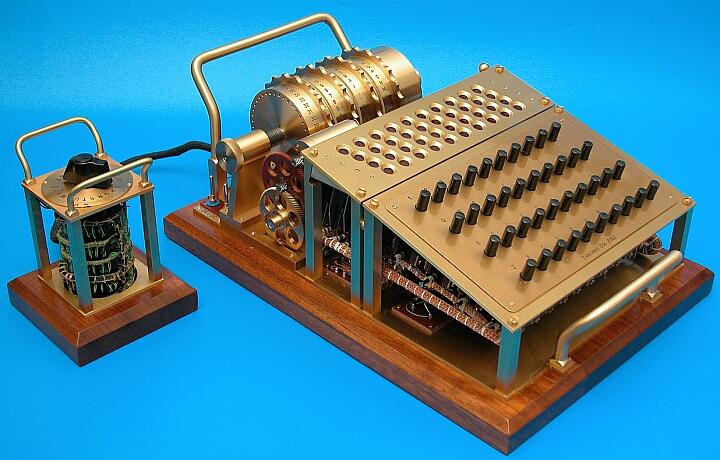
As she says on her page about it [vanvark] it’s not an ENIGMA, but it works the same way. If anyone wants to try their skill at cryptanalysis, she posted a bit of ciphertext of a haiku.

“… and, while I’m at it, I’ll make a printer.” And a paper punch tape drive (I wonder if it’s readable on an ASR-33)
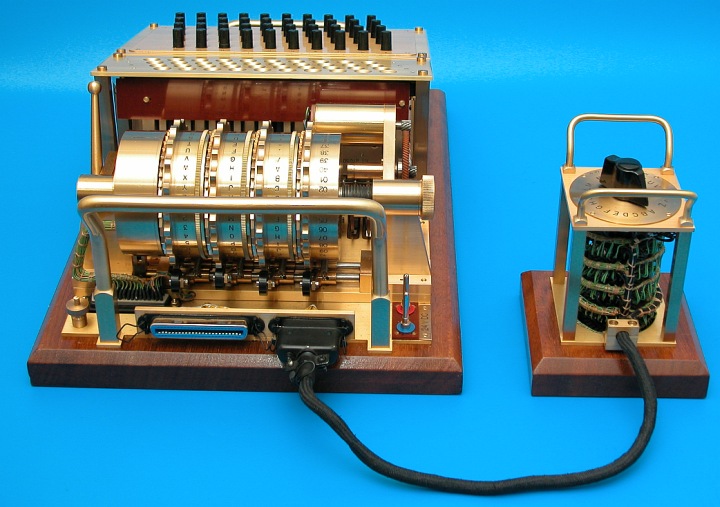
VanVark’s machine hasn’t got a steckerboard (plug-board) but it’s got this other selection-switch. I’d guess it does something similar – but, what?

What I love about this is that it’s a full-on 100% art project: there isn’t any aspect of the system that is not beautiful, functional, and uniquely quirky. When I was in high school I built burglar alarm panels for Moore Security, Inc., and I did a fair number of wiring harnesses. I know what I am looking at, and I am humbled. VanVark’s work is gorgeous! It’s “wiring harness as art”
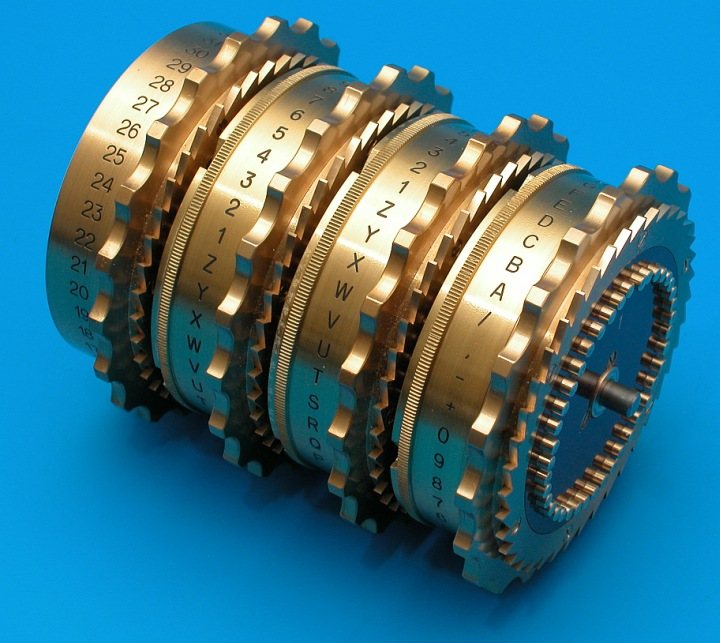
Her machine-work is from the school of “Look on my Works, ye Mighty, and despair!”
In case that doesn’t cement her technical chops, she also did a restore-to-working order build on a navigation and bombing computer for a 1950s Vulcan bomber.
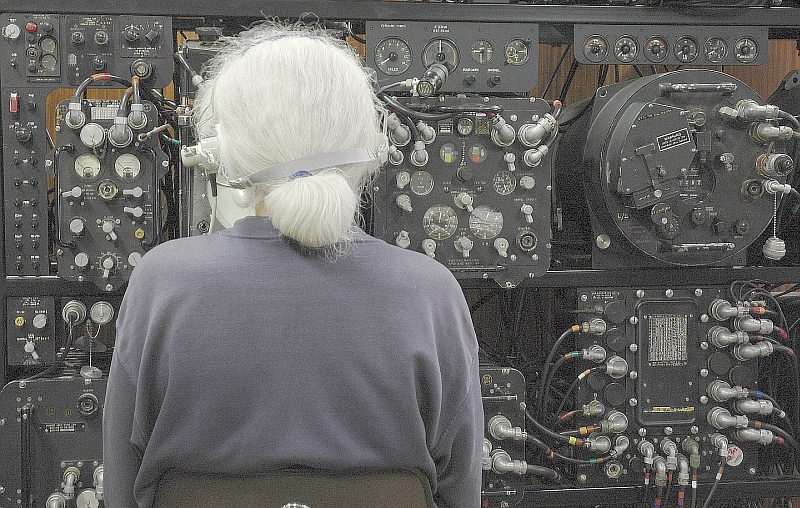
Her website is a cabinet of wonders: a lucite V-8 engine, a stainless steel 3D rendering of a tesseract, a restored LN32A inertial navigator, a machined 5-axis joystick, a hand-cranked plotter, and a bunch of other mysterious beautiful things.
Since I was posting pictures of the Yerkes Observatory [stderr] and its telescope, here’s a picture of the desktop newton telescope VanVark machined:
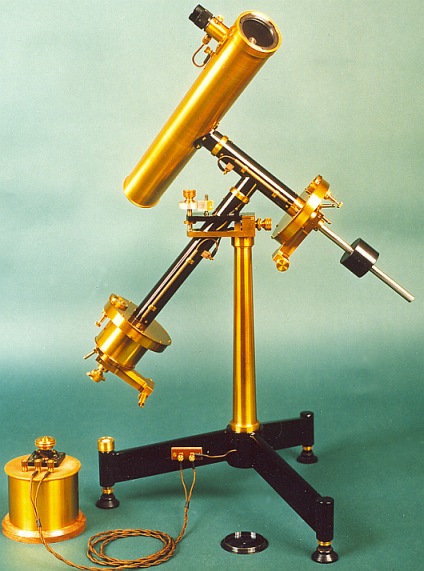

Since VanVark is wicked smart and understands ENIGMA machines (clearly!) I’d bet a lot that her haiku is carefully written to be harder to decrypt – free of crib-words. It’s already short enough that it’d be hard to mount a statistical attack on the ciphertext.
I should have mentioned in my piece on Bletchley Park, [stderr] the bombe in my photograph is a working reproduction that is patterned exactly off of one of the originals. That’s also an amazing piece of work. It makes me happy to know there are artists out there who can make stuff like this; it’s the antithesis of disposable culture.

I’d like to see her workshop.
chigau@#1:
There are some pictures of it on her site. It’s tiny but well-equipped and there’s nothing magical – just good tools.
She may be a genius in a machine shop but her web design is an ENIGMA.
There’s a bunch of stuff on her personally hidden here
Her work is exquisite. At the very first picture, I wondered where she could get such great parts, but of course the answer is going to be make it yourself. It’s the only way. :-)
Thanks, Marcus.
On my iPad, her website reloaded three times then crashed my browser, so I gave up.
I have real bad tool envy now.
Reminds me of this, a gigantic processor made of discrete transistors. Not so much art, but a machine made purely for the fascination of making it and seeing how it works.
kestrel@#3:
the answer is going to be make it yourself
I know, right?
And, as someone who makes stuff, yourself, you know that a huge part of the problem/process is that first you have to design the thing, make the patterns, see in your head how it will go together and what it’ll look like. Back when I was doing leather-work hats, I learned that “assembly order” was a big deal. It’s that way with wood and metal, too, but glue and stitches are a one-way process. So each piece has to not only fit, you have to figure it out in terms of the whole design. That applies even more so for something like her ENIGMA machine: she had to figure out how it was going to work, then figure out how to build it and in what order what pieces of those gorgeous wiring harnesses was going to go together. Because you can’t just pick the wiring harness apart, go back, add a wire, and have it come out properly. I can’t imagine debugging a machine like that, either. What if one of the lights doesn’t light up? It makes me want to scream and curl up in a ball, just thinking about it.
Holms@#6:
Reminds me of this, a gigantic processor made of discrete transistors. Not so much art, but a machine made purely for the fascination of making it and seeing how it works.
That is terrifying.
Can you imagine debugging that if it didn’t work right on the first power-up? (faints)
Some guy also made an ENIGMA machine in minecraft. That’s pretty nuts, too but at least there’s “undo”…
When you’re working with wire or machining brass “undo” looks a lot like a garbage can.
Dunc@#5:
Yeah. But it’s what she does with them that counts.
I have to say, there are things about her shop that make me weak-kneed with joy. Did you see that she has, basically, a hardware store worth of small brass parts? She can probably build just about anything without having to do more than walk across the room a bunch.
I also love the clutter. You can be sure that she has a mental map of all of it, and knows exactly where any thing is. My grandfather’s violin-making shop was like that: if you touched anything “put it back exactly where you found it” because he would reach over and grab a certain chisel or whatever, without even bothering to turn his head.
Marcus: I think of her as a “technology artist.”
That reminds me of Pirsig’s Zen and the Art of Motorcycle Maintenance, where he writes “A root word of technology, techne, originally meant ‘art.’ The ancient Greeks never separated art from manufacture in their minds, and so never developed separate words for them. …”
jgfn@#10:
That was one of my favorite books for a long time. It’s so meanderingly beautiful; more taoist than zen but what do I know?
The ancient Greeks never separated art from manufacture in their minds, and so never developed separate words for them.
Yes! Pirsig had an amazing way of dropping little nuggets like that.
Now why doesn’t that surprise me? ;)
My copy of Zen (it used to be my Dad’s) is so worn you could shuffle it.
The ancient Greeks never separated art from manufacture in their minds, and so never developed separate words for them.
Not just the Greeks, though. The Latin “ars”, which is were English got “art” from, could mean “skill” or “craft” too. The whole idea that “art” is something separate from skill at making things is fairly recent.
Fairly recent, that is, from a European perspective (to reference an earlier post). I’m not sure whether or not it predates the founding of the US, but it’s probably fairly close either way.
This is better https://en.wikipedia.org/wiki/The_Tao_of_Pooh.